Latin Monetary Union facts for kids
The Latin Monetary Union (LMU) was a special system in the 1800s that made several European currencies work together like a single currency. This was a big deal because most money back then was made of gold and silver. The LMU started in 1865 and ended in 1927. Even countries that didn't officially join the LMU often made their coins to its standards.
Contents
History of the LMU
How it Started
The LMU used the rules of the French franc, which was first created by Napoleon I in 1803. The French franc coins came in different values, like 5, 10, 20, 40, 50, and 100 francs. The 20-franc coin was the most common. It weighed about 6.45161 grams or 99.5636 grains of 90% pure gold.
In France, gold francs and silver francs could be swapped for each other. The rule was that 1 unit of gold was worth 15.5 units of silver. This was because that's how much gold and silver were worth compared to each other at the time.
The First Agreement
On December 23, 1865, France, Belgium, Italy, and Switzerland created the Latin Monetary Union. They agreed to use both gold and silver coins, following the 15.5 to 1 ratio of gold to silver that France already used. This meant one LMU Franc was worth 4.5 grams (69 grains) of pure silver or 0.290322 grams (4.48035 grains) of pure gold.
The agreement said that all four countries had to make gold and silver coins that could be freely exchanged. Before this, the amount of pure silver in coins varied a lot between countries. The treaty made sure that the largest silver coin (5 francs) was 90% pure silver. Smaller silver coins (2 francs, 1 franc, 50 centimes, and 20 centimes) had to be 83.5% pure silver. This agreement officially began on August 1, 1866.
The LMU helped countries trade with each other. For example, a French trader could accept Italian money for their goods, knowing it could easily be changed back into French francs.
More Countries Join In
After a big meeting in 1867, Greece joined the LMU on April 10, 1867. The treaty had a rule that allowed other countries to join if they followed the rules. Spain and Romania also thought about joining. They didn't officially join, but they tried to make their money similar to the LMU's standards.
Austria-Hungary didn't join because they didn't like using both gold and silver (bimetallism). However, they made a separate deal with France. They agreed to accept each other's gold coins at certain rates. Austria-Hungary even made some of its gold coins, like the 4 and 8 florin, match the French 10 and 20 franc coins.
Other countries also started using the LMU's system without officially joining:
- French colonies (like Algeria) started using it in 1865.
- Peru adopted the franc system in 1863.
- Colombia and Venezuela followed in 1871.
- The Grand Duchy of Finland adopted it in 1877.
- Serbia in 1878.
- Bulgaria in 1880.
- Coins made for Puerto Rico in 1895 also followed the standard.
- The Danish West Indies used the standard in 1904 but didn't join the Union.
- When Albania became independent in 1912, LMU coins from France, Italy, Greece, and Austria-Hungary were used there. Albania didn't make its own money until 1925.
However, not everything went smoothly. The Papal States (the area ruled by the Pope) started making silver coins with less precious metal than they were supposed to. These bad coins spread to other LMU countries, which made the Papal States money. Because of this, the Papal States were kicked out of the Union in 1870.
Problems Faced by the LMU
Gold and Silver Problems
From the very beginning, the LMU had problems because the value of gold and silver changed in the world market. This is a common issue when a currency uses both metals. When the LMU started in 1865, silver was worth a lot compared to gold. But in 1873, the value of silver dropped a lot. This meant people started bringing lots of silver to LMU countries, especially France and Belgium, to have it made into coins.
It became cheaper to make silver coins and then trade them for gold coins at the LMU's fixed rate. For example, in 1871 and 1872, the French mint received only 5 million francs worth of silver to make into coins. But in 1873 alone, they received 154 million francs!
To stop this flood of silver coins, the LMU countries agreed in 1874 to temporarily limit how much silver could be turned into coins. By 1878, the price of silver hadn't gone up, so they completely stopped making silver coins. From 1873 onwards, the Union mostly used a gold standard. People were expected to pay in gold, even though silver was still technically allowed.
Also, new discoveries and better ways to get silver meant there was more silver available. This made the LMU's fixed exchange rate for silver too high compared to gold. Traders, especially from Germany, would bring silver to LMU countries, turn it into coins, and then swap those for gold coins at a cheaper rate. These problems eventually forced the LMU to switch to only using gold for its money in 1878.
Cheating with Coins
Some members, like the Papal States, started making their coins with less precious metal than agreed. The Vatican made Papal lira coins with not enough silver (only 83.5% pure). Then, they would trade these bad coins for good coins from other countries. This forced other LMU members to deal with less valuable money.
Greece also had a weak economy. Its governments often put less gold in their coins. This made their money worth less than other countries' money in the Union, which broke the original agreement. Because of this, Greece was officially kicked out of the Latin Monetary Union in 1908. However, they were allowed back in 1910.
Paper Money Problems
Another big problem for the LMU was that it didn't stop countries from printing paper money based on the gold and silver currency. France and Italy used this weakness to print lots of banknotes to pay for their own projects. This meant other LMU members had to share some of the cost of their spending.
The End of the Union
The many wars and political problems in the early 1900s, especially World War I, effectively ended the Latin Monetary Union. Even though it officially lasted until 1927, it stopped working in practice much earlier.
The last coins made exactly to the LMU's standards (like size, weight, and silver purity) were Swiss coins from 1967. Today, Austria still makes gold coins that follow LMU rules for collectors.
What the LMU Achieved
A study in 2018 found that the LMU didn't have a huge effect on trade, except for a period between 1865 and 1874.
However, the Latin Monetary Union did inspire another similar system called the Scandinavian Monetary Union, which started in 1873.
Coins of the LMU
Below are some examples of 5-unit silver coins from different countries that were part of or used the LMU's standards:
| 5 Greek drachmae 1876 | |
|---|---|
  |
|
| George I of Greece | Coat of arms of Greece |
| 5 Belgian francs 1868 | |
|---|---|
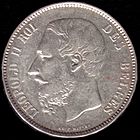  |
|
| Leopold II of Belgium | Coat of arms of Belgium |
| 5 French francs 1868 | |
|---|---|
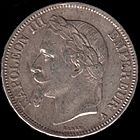 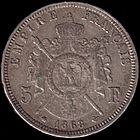 |
|
| Napoleon III of France | Coat of arms of the Second Empire |
| 5 Italian lire 1874 | |
|---|---|
 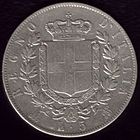 |
|
| Victor Emmanuel II of Italy | Coat of arms of the House of Savoy |
| 5 Spanish pesetas 1885 | |
|---|---|
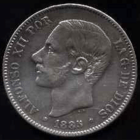  |
|
| Alfonso XII of Spain | Coat of arms of Spain |
| 5 Venezuelan bolívares 1912 | |
|---|---|
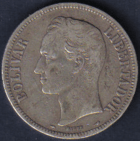 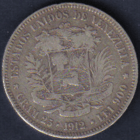 |
|
| Simón Bolívar | Coat of arms of Venezuela |
| 5 Swiss Francs 1889 | |
|---|---|
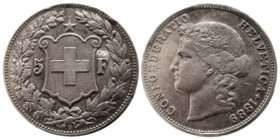 |
|
| Coat of arms of Switzerland | Libertas |
| 5 Romanian lei 1883 | |
|---|---|
 |
|
| Carol I of Romania | Coat of arms of Romania |
See also
 In Spanish: Unión Monetaria Latina para niños
In Spanish: Unión Monetaria Latina para niños
- Bimetallism
- Economic and Monetary Union of the European Union
- Euro
- Latin Union
- Spanish peseta
- Stella (United States coin)



